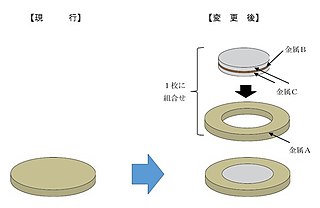Loading AI tools
Coin consisting of more than one metal or alloy From Wikipedia, the free encyclopedia
Bi-metallic coins are coins consisting of two (bi-) metals or alloys, generally arranged with an outer ring around a contrasting center.[1] Common circulating examples include the €1, €2, United Kingdom £1 and £2, Canadian $2, South Africa R5, Egyptian £1, Turkish 1 lira and 50 kurus, Indian ₹10 and ₹20, Indonesian Rp1,000, Polish 2 and 5 zł, Czech 50 Kč, Hungarian 100 and 200 Ft, Bulgarian 1 and 2 lv., Hong Kong $10, Argentine $1 and $2, Brazilian R$1, Chilean $100 and $500, Colombian $500 and $1000, Peruvian S/2 and S/5, Albanian 100 Lekë, Thai 10 baht and all Mexican coins of $1 or higher denomination. For a more complete list, see List of bi-metallic coins.

This section may require cleanup to meet Wikipedia's quality standards. The specific problem is: modern circulating coins list needs tidying up. (December 2020) |
Bi-metallic coins and medals have been issued for a long time. The Roman Empire issued special-occasion, large medallions with a center of bronze or copper and an outer ring of orichalcum, starting with the reign of Hadrian. Meanwhile, circulating bi-metallic coins are known from the 17th century.[2][3] English farthings from 1684 through 1693 were made of tin with a central plug of copper for value. The silver-center cent pattern produced by the United States in 1792 is another example.[2]
In the 1830s and 1840s, British medalist Joseph Moore produced large numbers of bi-metallic "penny model" and less common "halfpenny model" tokens, as a proposal to replace the relatively large penny and halfpenny coins.[4][5] Though not legal tender, Moore's tokens were circulated widely and accepted at face value by many merchants. Despite their popularity, the Royal Mint rejected the proposal, and did not reduce the size of the penny and halfpenny until decimalization.[6]
The first modern circulating bi-metallic coin was the Italian 500 lire, first issued in 1982.[7] Based on the minting process of the lire coin, A list of All bi-metallic coins can be found here
The first ever tri-metallic circulating coins were 20-francs coins introduced in France and Monaco in 1992. These were similar to the corresponding bi-metallic 10-francs coins, but had two rings instead of one.
As well as circulating coins, where they are generally restricted to high-denomination coins, bi-metallic coins are often used in commemorative issues, often made of precious metals. For example, the only bi-metallic coin issued by the United States is the $10 Library of Congress commemorative, made of a gold ring around a platinum center. They are used primarily as a way of securing against coin counterfeiting.[8]

The manufacturing process is similar to that of ordinary coins, except that two blanks (the inner and the outer) are struck at the same time, deforming the separate blanks sufficiently to hold them together.[9]

Seamless Wikipedia browsing. On steroids.
Every time you click a link to Wikipedia, Wiktionary or Wikiquote in your browser's search results, it will show the modern Wikiwand interface.
Wikiwand extension is a five stars, simple, with minimum permission required to keep your browsing private, safe and transparent.